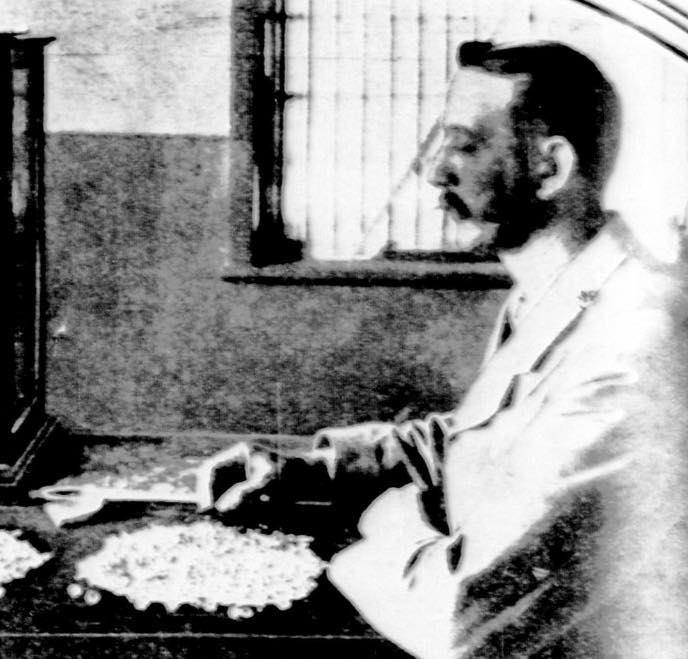
The following article on testing diamonds was published in 1905 and discusses the methods regular people could use to try and figure out if a diamond was real or glass. I wouldn’t personally recommend these methods, but I am putting them up here for research purposes.

Good Tests For Diamonds
If you doubt the genuineness of your diamonds or stones which you contemplate purchasing, it is not necessary to submit them to an expert — by studying the following methods of testing these gems you may become your own expert.
For the first lesson, take a real diamond and an imitation. Drop them in glasses of water. The imitation will blend with the water and become almost invisible, while the real one will be distinctly visible, shining out whitely through the liquid. Dry and clean the two stones, and on the flat side of each put a tony drop of water. On the real the drop will hold its globular form and can be led about with a pin point. The drop on the glass one will spread.
Study the two stones with a magnifying glass. The facets of the false one are even and regular. On the other they are of varying sizes. The reason for this is that a diamond cutter with a good gem will sacrifice symmetry to weight, preferring to leave some slight irregularities in the planes and edges than to reduce the stone’s value. The material in a false stone being of little value, the cutter makes as finished a job as he can of it, the appearance counting for more than the stone itself.
If a real diamond be used as a miniature reading glass, aided by a large magnifying glass, a tiny dot on paper appears clear and clean. Substitute the false stone, and several points, or one badly broken one, will be seen owing to unequal refraction.
Then you can try the familiar experiment of scratching a sheet of glass. Because your stone will scratch does not prove its genuineness, however. Try to break the glass evenly on the scratch. No other stone can cut through the outer skin of a sheet of glass and give certainty to an even fracture like a diamond.
Your true diamond is proof against the hardest file, but the instrument will easily scratch any imitation that has ever been made.
Having scratched your pretty bit of glass till it is worthless, drop it and the diamond into hydrofluoric acid. Before long the glass will be dissolved, but the diamond will suffer not at all.
Then there is still another experiment. Take a bit of stuff with red and white markings, pass the stone to be tested over it, and closely observe the result. If the stone be an imitation the colors will be distinguished through it; if it be a diamond no difference of color will be appreciable.

A genuine diamond rubbed upon wood or metal, after having been previously subjected to the rays of the electric arc, becomes phosphorescent in the dark; this cannot be said of any of the imitations. If the stone to be tried be covered with moral paste, and after being well heated in the alcohol flame, dropped into a glass of water, the proof will be instantaneous. The glass imitation will fly into bits, while the genuine stone will not be affected. Finally, try to crush between two hard plates a diamond and an imitation and learn the difference.
After the diamond, the sapphire is the hardest stone; with her more beautiful sister, she possesses also the quality of resisting the attacks of the file, but she is, however, cloudy in appearance and of a milky hue. The topaz is slightly yellowish and surrenders to the cutting teeth of the file. There are a great number of white diamonds, but a pure, clear, transparent stone without a shade of color is more rare than is often supposed.
Besides white diamonds, here are some which exhibit the shades of red, blue, green, yellow, brown, black, and pink. Heat sometimes causes a diamond to change its color, and after a time the color thus acquired becomes permanent. Yellow diamonds, or those commonly denominated “off color,” furnish the greatest variety of shades and some of them exceed in beauty all other stones of that color.
Specimens of canary-colored diamonds are by no means rare. They may almost be said to be common. A pink or rose colored diamond is of great value, and the red diamond, surpassing the ruby in its magnificent coloring, is considered the most beautiful of all the precious stones, being exceedingly rare. The one bought by Paul, Czar of Russia, weighed 10 carats and cost him two and one-half million francs. A perfectly black diamond is almost as rare as a red one.
For beauty the blue stones come directly after the red diamonds. Those possessing the deep blue, and in this respect resembling the sapphire, are indeed most beautiful gems, differing from the sapphire only in quality and by the magnificent fiery colors peculiar to the diamond. The only true blue diamonds come from the mines in India. The varieties of green are not so rare as the blues, reds, blacks, and pinks, but those of grass green hue like the beautiful emerald are seldom found. Where they do exist, however, they surpass in brilliancy the finest emerald.
In place of the Brazilian diamond, which of late years has become quite scarce, Cape diamonds of much inferior value and brilliancy are often sold. To be able to distinguish between these gems is an accomplishment possessed by the few.
The Pacific Commercial Advertiser. Newspaper. March 20, 1905.

